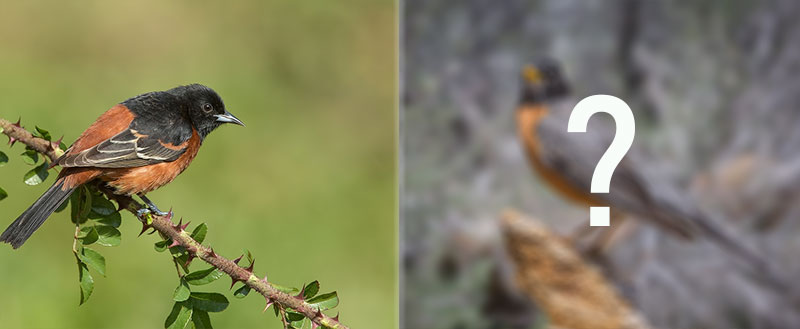
Orioles are some of the most gorgeous birds in North America. Their bright orange, yellow and black plumages lend a cheerful, colorful touch to any backyard!
However, some aren’t always easy to identify. Some look similar to each other and other non-oriole bird species.
Want to learn how to recognize orioles? See this article for tips to identify them and recognize other birds that look like orioles!
Identifying Orioles
Fortunately, it’s pretty easy to identify birds as orioles. These blackbird species always have a sharp, pointed beak, and the males always have distinctive plumages and field marks.
However, females and young birds can be tricky. Although we can still recognize them as orioles by their sharp beaks and orange or yellow plumage, we have to look at other field marks to tell them from each other.
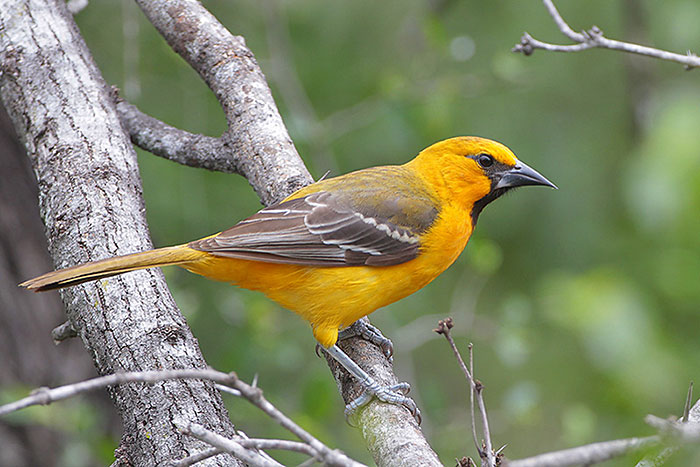
To identify orioles, the first thing to look at is the bird’s head. Does it have a full black hood, or does it just have black on its face and throat? Next, how much white does it have in its wing? Answer these two questions, and you can identify just about any male oriole.
As for young birds and females, we also have to focus on the pattern on their heads and in their wings. Details can be used to identify confusing female orioles to species.
We can also tell them from similarly patterned warblers and female tanagers by noting their sharp pointed beaks and long, slightly rounded tails.
American Robin
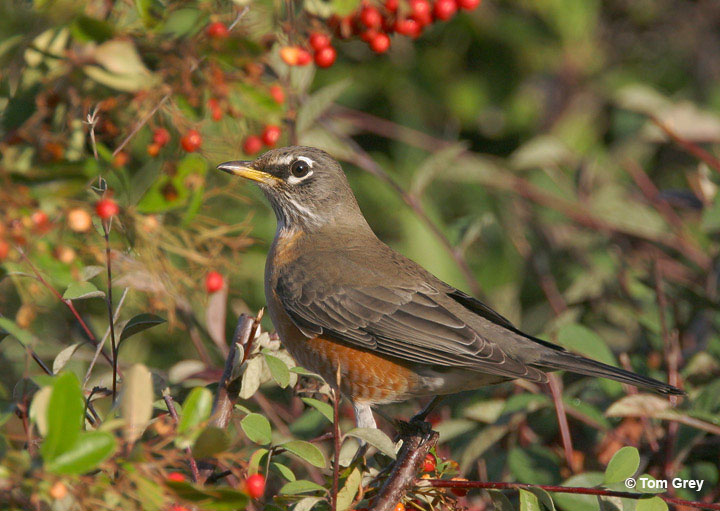
American Robins are familiar birds, around ten inches long. They are dark gray above, brick red below, and have white on their belly and a bit of white around their eyes and on their throats. This common bird also has a yellowish beak and is more blackish on their head and tail.
With a close look, we can also see a bit of white on the outer corners of their tail feathers. Females resemble males but are paler and duller overall.
Learn more: Birds that look like robins
American Robins live in a lot of the same places as orioles, but they aren’t all that similar to them. Although robins have dark heads sort of like a Baltimore Oriole, it doesn’t contrast as much, and it’s not a full black hood.
Robins also have more brick red colors than the bright orange shown by orioles. Their behavior is also quite different. Orioles forage high in trees, while American Robins stand and hop on open lawns.
Evening Grosbeak
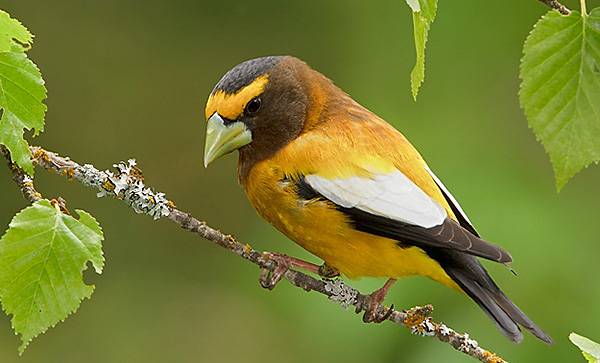
Photograph © Glenn Bartley.
Evening Grosbeaks are chunky finches with big, pale, conical beaks. Males are dingy yellow and have bright yellow eyebrows on dark brown heads.
They also have big white patches on their long, blackish wings, and have a rather short dark tail. Females and young birds are grayer with just a hint of yellow.
Male Evening Grosbeaks have a plumage pattern and colors a bit like a Scott’s Oriole or an Audubon’s Oriole.
However, those orioles don’t have the grosbeak’s yellow eyebrows, nor its big white wing patches. They also have narrower, more pointed beaks, and longer tails.
Evening Grosbeaks also rarely if ever occur in the same places as those two oriole species. While grosbeaks will eat seeds at feeders, perch in tall trees, and live in mountainous areas, Scott’s and Audubon’s Orioles do not feed on birdseed and are more birds of low, open vegetation.
Western Tanager
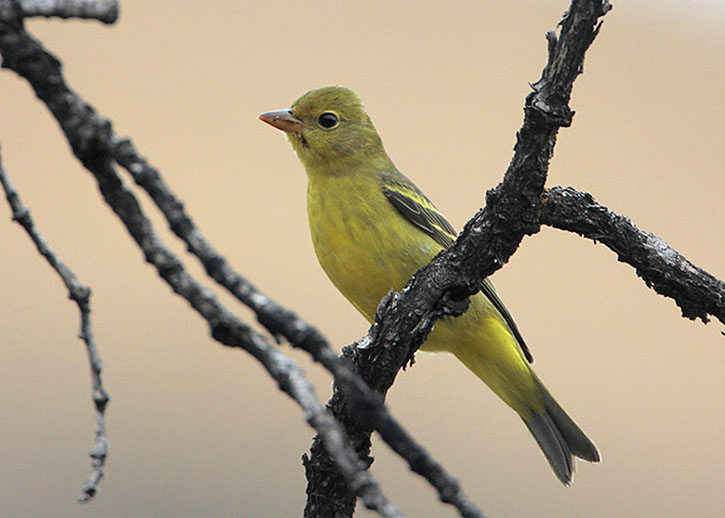
Female Western Tanager
Western Tanagers are small to medium-sized songbirds of western habitats. Males of these gorgeous summer birds are bright lemon yellow with rose-read on their head, and yellow and white on their long black wings. They also have a black back and tail.
Female Western Tanagers are more dingy green-yellow and gray birds with two pale wing bars on dark wings. They also have a pale, stout beak.
While males of this beautiful species are easy to recognize, females can look a bit like an oriole. Like female Hooded Orioles and a few other oriole species, female Western Tanagers are green-yellow birds with two pale wing bars.
Western Tanagers can also forage in the same trees and bushes as Bullock’s Orioles, Hooded Orioles, and Scott’s Orioles. In general, though, they prefer oaks and coniferous woodlands.
However, we can always recognize any Western Tanager by their stout, pale beak. No oriole has a bill like that!
Yellow-headed Blackbird
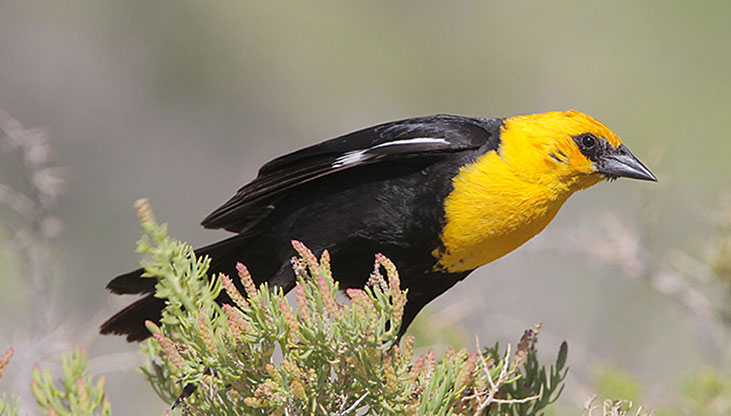
Yellow-headed Blackbirds are fair-sized songbirds around the same size as an American Robin. Males are black with bright yellow heads and chests and have a small black mask, and a white patch in each wing.
Young birds and females are more sooty brown with dingy yellow on their head and chest.
While these blackbirds of open marshes share some plumage colors and patterns with orioles in general, they really don’t look anything like them.
They are much darker overall and have more black on their bodies than any other species. While they do have sharp, pointed beaks, their bills are all black and much shorter than those of orioles.
Orioles with yellow plumage, such as the Scott’s Oriole always have pale or yellow bellies, and also have pale wing bars. Yellow-headed Blackbirds never show these field marks.
Unlike most orioles, Yellow-headed Blackbirds also live in open fields and marshes and flock together.
Blackburnian Warbler
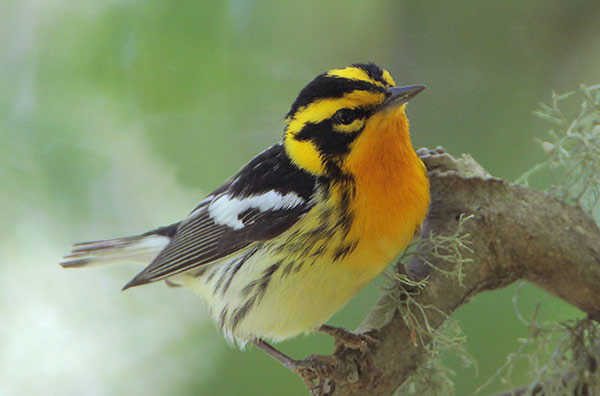
Blackburnian Warblers are small, beautiful black and orange birds. In spring and summer, males also have bright orange on their heads, a black cap, black markings on their face and sides, a white patch on each wing, and pale yellow and white bellies.
Females and males in fall have two pale wing bars and pale orange or yellow instead of deep fiery orange.
With their orange colors and wing bars, these warblers can remind us of female Baltimore Orioles or a male Bullock’s Oriole. However, they are much smaller, and have a different shape.
Orioles have a bigger, sharper beak, and a longer, more rounded tail. Speaking of tails, Orioles also lack the white spots that Blackburnian Warblers show as they open and close their tails while foraging for insects.
We can see Blackburnian Warblers in the same trees as Baltimore Orioles but the warblers are a lot more active.
American Redstart
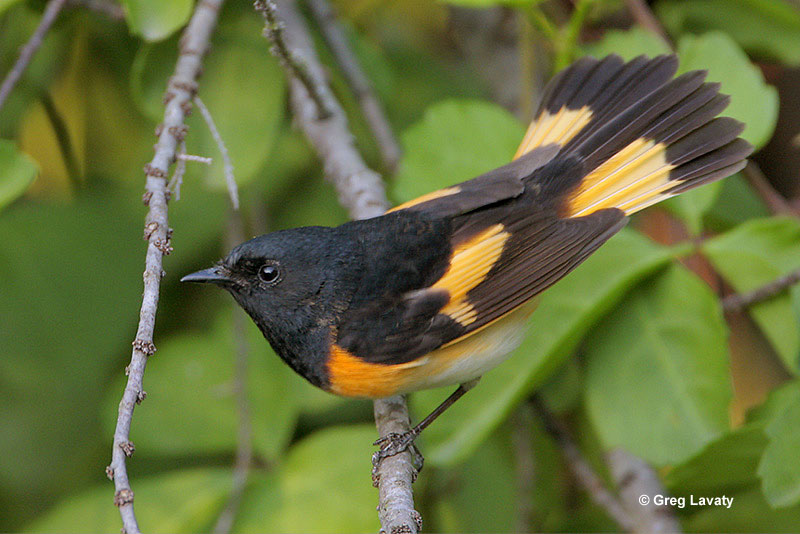
American Redstarts are another warbler species that can remind us of orioles. American Redstarts and Baltimore Orioles do live in a lot of the same places but are pretty easy to tell apart.
Like a Baltimore Oriole, the male American Redstart also has black and orange plumage. However, while the oriole is orange with a black hood, and has black in its wings and tail, the male redstart is mostly black with a couple of orange patches on its sides, wings, and tail.
Female and young American Redstarts look very different and aren’t usually confused with orioles. They are mostly gray and white with some yellow or orange on their sides, wings, and tail.
These small warblers also forage very differently from orioles. While Baltimore Orioles slowly forage high in trees, American Redstarts quickly flit around and sally for bugs in trees and bushes. They also cheerfully open and close their tails while looking for insects.
Black-Headed Grosbeak
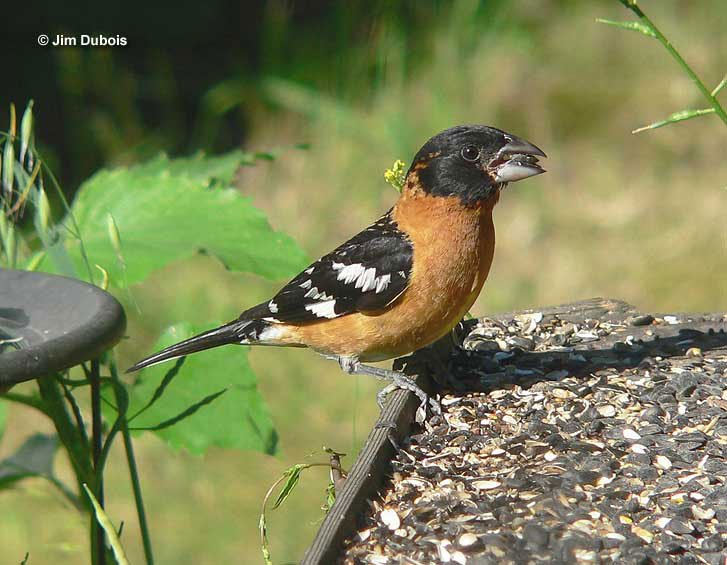
Black-headed Grosbeaks are chunky songbirds with thick, conical beaks. Males in breeding plumage are black and burnt orange birds that can be easily confused for an oriole. They can also use similar vegetation. However, with a closer look, we can see that they don’t really look like any known oriole species.
Male Black-headed Grosbeaks are dark orange with a pale yellow belly and a black head. They also have pale streaks on their black back, and white markings on their black wings and tail. Females and young males are browner, streaked, sparrow-like birds that don’t look anything like orioles.
Although the breeding male’s plumage resembles that of a male Baltimore Oriole or even a male Orchard Oriole, the orioles have full black hoods. They also don’t usually live in the same areas as the grosbeak.
However, the easiest way to tell this grosbeak from any oriole is by its beak. Unlike orioles, it has a thick, conical, finch-like beak.
American Goldfinch
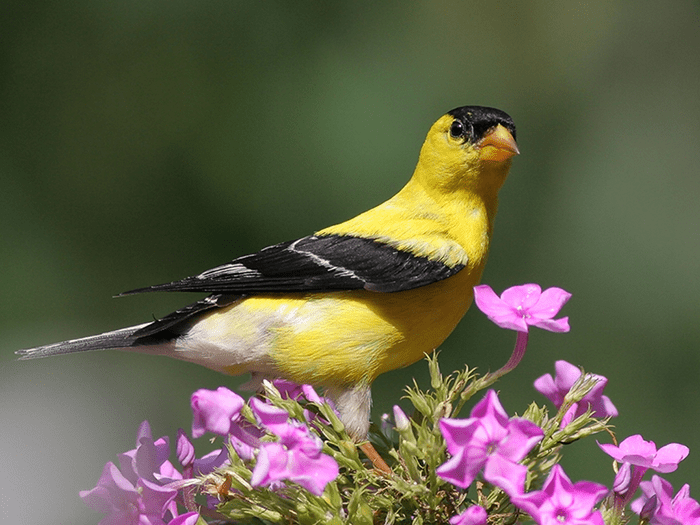
American Goldfinches are small, pretty songbirds with dainty conical beaks. Males in breeding plumage are bright yellow, have a black cap, long black wings, and a black and white, forked tail.
Females and wintering males are plainer, pale brown and gray birds with two pale wing bars. On account of their yellow and black plumage, breeding plumage males are sometimes confused with being orioles.
However, they are much smaller and look more like a small sparrow or small finch (which they are). Goldfinches also have small and conical beaks and short forked tails, while orioles have longer pointed beaks and longer, slightly rounded tails.
In addition, the main oriole species with yellow and black plumage, the Scott’s Oriole, has a black hood. Breeding male American Goldfinches only have a small black cap.
Finally, we usually see goldfinches in flocks that visit feeders and open weedy fields. Scott’s Orioles probe flowers and don’t eat birdseed.
Northern Red Bishop
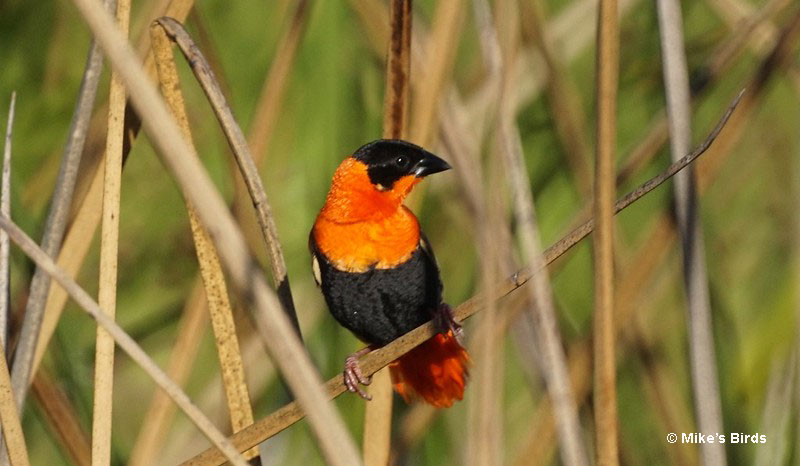
Northern Red Bishops are beautiful little finches sometimes assumed to be orioles. Somewhat like orioles, male Northern Red Bishops have striking black and red-orange plumage. However, they are more red-orange than orange and have these colors on most of their upperparts along with black on their underparts and crown.
This is more or less the opposite of plumages shown by the Baltimore Oriole and other oriole species. Instead of having black on their bellies, male orioles have orange or yellow underparts. Orioles are also bigger, more slender birds than the bishop, have longer, more pointed beaks, and much longer tails.
Female Northern Red Bishops don’t look anything like orioles, either. They are small, brown, sparrow-like birds with streaks on their upperparts.
We can also tell Northern Red Bishops from orioles by their behavior. The bishops like low, open habitats and can eat birdseed, while Baltimore Orioles prefer taller vegetation and only visit feeders for jelly or nectar.
Scarlet Tanager
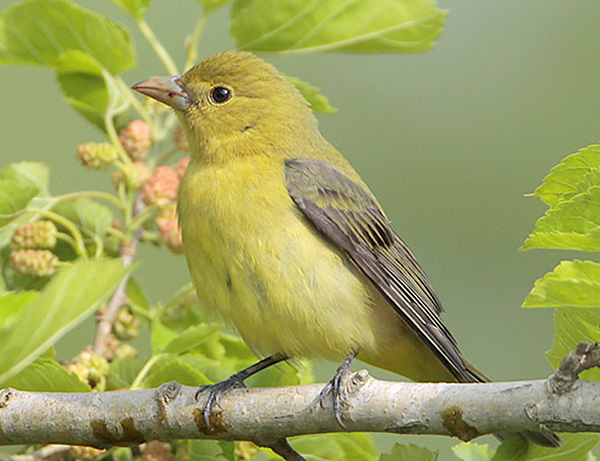
Female. Photograph © Greg Lavaty.
Scarlet Tanagers are similar in size to orioles and live in the same places as Baltimore Orioles. They can often be seen in the same trees! Like orioles, breeding male Scarlet Tanagers also have bright colors.
However, they don’t have the same colors nor the same plumage pattern as the Baltimore Oriole. While Baltimore Orioles are orange and black, breeding male Scarlet Tanagers are bright red with jet-black wings and tails.
They also have a stouter gray beak. Female and fall-plumaged Scarlet Tanagers can also remind us of an oriole. They are greenish birds with dark wings and a dark tail. However, female Baltimore and Orchard Orioles are more slender birds that always have pale wing bars, long tails, and sharp, pointed beaks.
Tanagers also rarely if ever visit feeders. Instead, they spend most of their time foraging for bugs high in trees. Orioles also like tall trees but also come to feeders to eat grape jelly.
Lesser Goldfinch
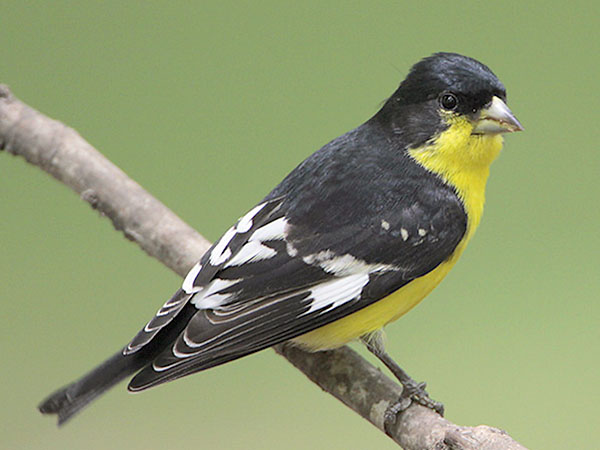
Photograph © Greg Lavaty.
Lesser Goldfinches are very small, black and yellow finches with small, conical beaks, and have some white markings on their long black wings. Males can be olive above, yellow below, and have a black cap. Or, they can be all black above and bright yellow below.
Either way, their black and yellow colors can remind us of an oriole, especially the Scott’s Oriole and Audubon’s Oriole. However, their plumage patterns are different, and they also differ in other ways.
Males of both of these oriole species have a full black hood, while the goldfinch only has a black cap, or has yellow on its face and throat. The goldfinch is also much smaller and daintier than any oriole. It has a shorter tail and is a small finch while orioles are slender birds with longer tails and longer, sharp beaks.
Groups of Lesser Goldfinches also visit feeders for birdseed, while orioles only occasionally visit to eat jelly.
Have you seen any species you’ve mistaken for orioles at first? Let us know in the comments!

